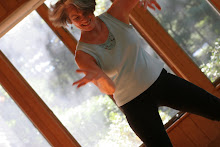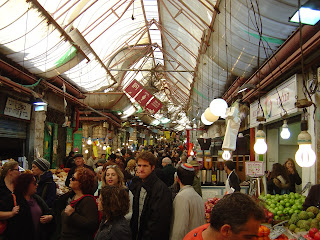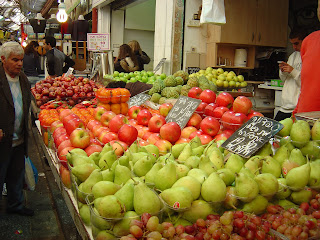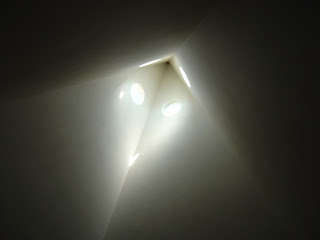|
Journey to Jordan
|
Sunday
morning, December 11, 2011. Up at 5,
luggage out before 6, breakfast at 6, rolling at 6:30. The good thing about traveling in winter is
the pleasant weather. Aside from some
wind and rain on Erev Shabbat, we have had nothing but sunny weather. The difficult thing about traveling in winter
is the brief sightseeing day. The sun is
setting at 4 and most tourist venues close at that time. Hence the early morning. Our bus is comfortable, with plenty of room
to spread out. Leslie and I each take
two seats in the back of the bus, across the aisle from each other.
We
are crossing the border at Beit Shean in the north. Originally, we had planned to cross at the
Allenby Bridge. A security advisory from
the government suggested Beit Shean as a better choice. Allenby is where many Palestinian laborers
employed in Israel cross each day. The
touring company decided it was better to separate the tourist crossing to a
different location.
Flocks
of migrating birds gather in the fields in early morning. Gilah is taking us up to the border , where
we will transfer to a Jordanian bus with a local guide. She points out that landscaping is not part
of the Arab culture. The communities in
Arab villages are not very organized. Most
important is what is inside the house. Many
homes are multiple generations of a single extended family.
Along
the road, we see Arab villages, Israeli
settlements, and Bedouin communities.
Bedouins are no longer nomadic, for the most part. Tents became shanties, then homes, now more
and more elaborate. Israeli
license plates are yellow, Palestinian plates blue or green.
The
border crossing was easier and quicker than I expected. We had to load all our
things from our Israeli bus onto a shuttle bus in the secure area, then unload
again and reload onto a Jordanian bus.
This involved several steps:
- Israeli passport control and
payment of $32 border crossing fee
- Transfer of luggage to neutral shuttle
- Jordanian passport control
- Transfer luggage again from
shuttle to Jordanian bus.
This
process saved time. If we continued into
Jordan with an Israeli bus, it would have to be inspected on the way in and
out, two hours or more each way.
Our
Jordanian guide is Rami, similar to our Israeli guide Ronny. Our bus driver's
name is Suleiman, Solomon in English, Schlomo or Schlomi in Hebrew, the same as
our Israeli bus driver.
Our
first stop was a walking tour of Jerash, ruins of an ancient Roman city near
the modern Jordanian city of Jerassa. The entrance to the ruins is a huge arch
called Hadrian's arch, constructed to commemorate a one-month visit by the
Roman emperor to the city. Excavated ruins include roads with columns, an oval
plaza, temples for Zeus and Artemis/Diana, and a theater in the round. A Jordanian quartet played a bagpipes and
drums performance for us. Acoustics in
the theater were excellent. I had worn
my clogs to give my feet a break from lace up shoes. They were not a good
choice on the stone streets of Jerassa. I got an amazing workout for my legs from
walking on the uneven surfaces in the clogs.
My legs were very tired at the end of the day.
We
stopped for lunch at a restaurant with a banquet style buffet, middle Eastern
salads and meats, fruit for dessert. The
meal was served with lovely refreshing drinks.
I chose lemon and mint.
Next
we drove to a Greek orthodox church in the city of Medaba where we saw the
oldest map of the holy land in mosaic on the floor. This map was used by the
archeologists in Jerusalem to locate the cardo in the recent excavations of the
old city. Medaba was the hometown of our guide Rami.
We
drove to Mount Nebo where Moses is said to have died and be buried, although we
don't know where his grave is. Aaron's grave is known to be on Mount Hor to the
south. Mount Nebo was where Moses stood and looked toward the promised land. God told him that he would die there and not be
allowed to enter the holy land. It was
not certain that we would arrive there before their early closing time of
4:00. We arrived at 3:50.
I was fascinated with the visitor’s center
which was a traditional Bedouin tent made with woven goat’s hair. The goat’s hair is oily, providing protection
from wind, rain, dust. Multiple colors
of goat hair are used. Today, tents are
supported by aluminum poles, stronger, steadier, and more reliable than the
traditional wooden poles.
Rami
read to us from Deuteronomy about Moses's experience there. Then Rabbi Weiner
gave a brief homily about Moses facing toward Jerusalem to pray. He explained
that, even though Moses knew he was not going to make it into the promised
land, it was still important for him to know where he was heading. Similarly, though
we may never make it to our goal, having a goal is important to direct our
steps.
Our
last stop of the day was a factory that produces mosaics. Fed by tourist’s interest in ancient mosaics
in the area, the government supports the growth of this industry. Near the church we visited in Medaba is a
school that teaches the production of mosaic art. The factory where we stopped is supported by
a private foundation and subsidized by the Jordanian government. Disabled people are trained there and paid to
work four hours a day producing mosaics. Several images are repeated over and
over. One favorite theme is The Tree of
Life, a depiction of a tree in the center, with three gazelles eating the
leaves of the tree and a lion attacking one of the gazelles. The store attached
to the factory was massive with goods produced in the factory by hand: mosaics,
fake painted mosaics on table tops, dishes, also rugs, scarves, dresses, pillow
covers. Salespeople tagged each of us,
encouraging us to buy something.
We
arrived at our hotel in Amman about 6:30, just in time for our shared dinner at
7. Leslie and I returned to our room about 8:30 and climbed into bed right
away, slept until my alarm sounded at 5. The room was seriously overheated, so much so
that even with the door to the balcony open, it was still uncomfortably
hot. I called the desk and learned that
they had switched from air conditioning to heat and that they were not able to
control the temperature in the rooms. A
little later, they sent up a fan which we kept running all night. It cooled the room enough so that we slept
well.
The
Jordanian government is a monarchy led by King Abdullah II and Queen
Rania. Queen Rania was born a
Palestinian in Kuwait. When King Abdullah
II and Queen Rania married in 1993, they did not suspect that he would become
king. The Crown Prince was King Hussein’s
brother Hassan. However, on his death
bed, King Hussein named his son Abdullah as his successor. Abdullah ascended to the throne at the death
of his father two weeks later.
The
Jordanian flag has four colors: a red triangle commemorating the Great Arab
Revolt of 1916. On it is a 7-pointed
star representing the seven verses of the opening Sura of the Kuran. The three stripes from top to bottom are
black representing the Abbasid Caliphate, white for the Ummayyad Caliphate, and
a green stripe on the bottom for the Fatimid Caliphate.

































